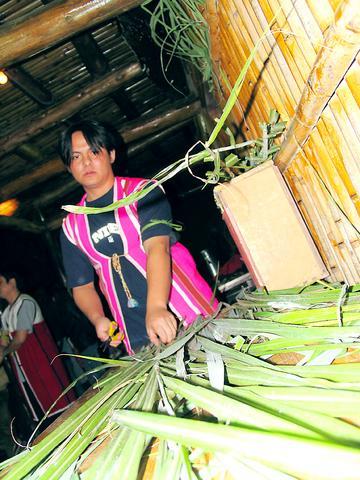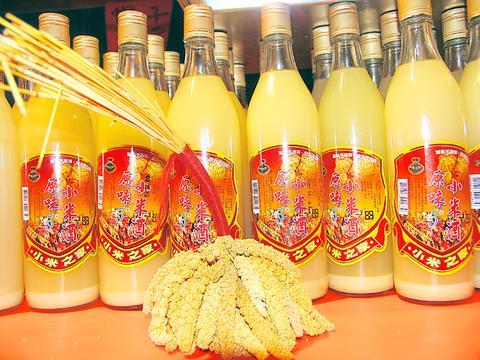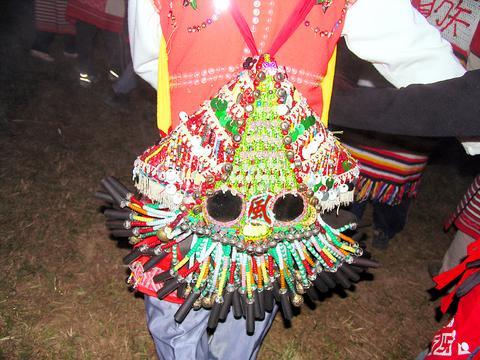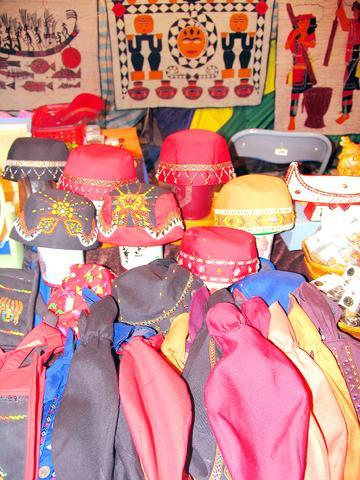Linked hand-by-hand to hundreds of other dancers, we whirled around like dervishes. At other times, we rhythmically rocked back and forth, or shuffled in a circle. All the time, the tribal elders were singing simple trance-like chants that rose and fell. The moon was high, bright and full above us.
In the amphitheater's stands, at the staging area for the biannual "Ritual of the Short Black People" (

PHOTO: JULES QUARTLY, TAIPEI TIMES
The ritual was festival-like, even ecstatic at times. It was staged like an open-ended concert in that the audience members were also performers in a drama that has been re-enacted for ages. You could watch the action from the gallery and buy hongs or share rice wine, beer, cigarettes and betel nut; or take a stroll around the arena, to the stalls selling local crafts, roasted wild white pig and other delicacies; or join the dance.

PHOTO: JULES QUARTLY, TAIPEI TIMES
There were around 4,000 people of all ages at the site, perched at an elevation of 1,500m in the Central Mountain Range. There were no amplifiers, except for the tannoy that occasionally broadcasted information. Around 80 percent of those present were from Aboriginal tribes, mainly Saisiyat and Atayal. There were some Chinese businessmen supplying arcade machines or roadside stalls, students and local tourists, some Japanese (mainly media) and 10 or so foreigners.
Before the dancing on Saturday that began at 6pm, there was a ritual held in private by Saisiyat tribal leaders, of which there were six main families, led this year by the Zhu (

PHOTO: JULES QUARTLY, TAIPEI TIMES
I was staying at a hospitable Zhu family home in the area and the next morning the sounds of parties going on in the surrounding hills filled the air. Gradually, these sounds were submerged by the trill of karaoke sessions that lapped over a lazy Sunday afternoon, as people ate and rested and toasted each other.

PHOTO: JULES QUARTLY, TAIPEI TIMES
The Saisiyat tribe -- which is said to have killed off the last of the black pygmies that were likely the earliest settlers of Taiwan -- has held the Ritual of the Short Black People for around 100 years, ever since their extermination is believed to have happened.
The Saisiyat have held similar kinds of dances for millennia, often with the pygmies. They were possibly performed many thousands of years earlier by that ancient race which, until relatively recently, lived in caves at the bottom of one of the mountains in the area, by a stream.
The previous night in Nanchuang Township, Miaoli County, starting around 10pm for outsiders, there had been a cycle of rituals held every two years to commemorate the Short Black People.
Two connected Saisiyat tribes, those from Hsinchu and Miaoli, hold complementary rituals and sometimes the same rituals in different sites. The god of the Short Black People was transported between the two staging areas, from Nanchuang to Wufeng for Sunday night's dances. Yesterday morning and early afternoon was a final ceremony involving chopping down a sacred tree.
The Nanchuang ritual was held near Xiangtian Lake, in the mountains of Miaoli, about an hour's drive from Wufeng over the ragged peaks. It began by welcoming the god of the Short Black People. There was no amphitheater, just a staging ground, a private ritual room, basic changing areas and hundreds of stalls or makeshift shops that spilled over an area that was bounded by woods. Small tent cities had mushroomed and the four-day event had just begun.
It was colder, darker, open to the elements and had a more mournful feel. A man stood in the middle of swaying dancers cracking a whip. The elders' singing seemed more trancelike, more like a dirge. They had microphones that made them sound like muezzin calling the faithful to prayer.
The dancing seemed slower and more ponderous, compared to the feeling of celebration at Wufeng. The dancers were directed by senior tribal members and some carried poles decorated in silk and tinsel. Others stewarded the dancing, stopped people getting in the way and prevented photographers from taking shots from inside the dance. Taking photos was prohibited in the 11 rules that were handed out with the shuttle bus ticket to the site.
In addition, visitors had to enter with a "sincere heart," show respect, not fight or argue, not go in the private ritual area, and follow the steps and lyrics as directed, not make up your own. The rules did not mention that a mangtsao, a long leaf similar to bamboo, needed to be tied to your arm to prevent trouble from the spirits of the awakened Short Black People. The stewarding was friendly, but firm, often ending in a shared drink of rice wine.
As to my feeling that the mood of the two events had been different, several Aboriginal elders assured me the dances and 16 songs were the same and the ritual is basically similar at both places. They looked quizzical and amused, though one said the Wufeng festival was more "modern."
As we watched the dancers sway and circle, Mwa, who is in his 80s, looked healthy and was happy with the drink and excitement. He said that three generations of his family have taken part in the Ritual of the Short Black People. When he was young, he said, there were slightly fewer people compared with the 5,000 or so who turned up in Nanchuang on Friday. But, he said there were more Saisiyat then, fewer Atayal (the neighboring tribe), Chinese and foreigners.
The Saisiyat are said to number approximately 5,000. They are dwindling in number and many marry into Atayal or Han families.
Mwa offered no opinions but gave me a drink instead and we toasted each other, as did those in the same place for a similar ritual long ago.

June 2 to June 8 Taiwan’s woodcutters believe that if they see even one speck of red in their cooked rice, no matter how small, an accident is going to happen. Peng Chin-tian (彭錦田) swears that this has proven to be true at every stop during his decades-long career in the logging industry. Along with mining, timber harvesting was once considered the most dangerous profession in Taiwan. Not only were mishaps common during all stages of processing, it was difficult to transport the injured to get medical treatment. Many died during the arduous journey. Peng recounts some of his accidents in

Taiwan Power Co (Taipower, 台電) and the New Taipei City Government in May last year agreed to allow the activation of a spent fuel storage facility for the Jinshan Nuclear Power Plant in Shihmen District (石門). The deal ended eleven years of legal wrangling. According to the Taipower announcement, the city government engaged in repeated delays, failing to approve water and soil conservation plans. Taipower said at the time that plans for another dry storage facility for the Guosheng Nuclear Power Plant in New Taipei City’s Wanli District (萬里) remained stuck in legal limbo. Later that year an agreement was reached

What does the Taiwan People’s Party (TPP) in the Huang Kuo-chang (黃國昌) era stand for? What sets it apart from their allies, the Chinese Nationalist Party (KMT)? With some shifts in tone and emphasis, the KMT’s stances have not changed significantly since the late 2000s and the era of former president Ma Ying-jeou (馬英九). The Democratic Progressive Party’s (DPP) current platform formed in the mid-2010s under the guidance of Tsai Ing-wen (蔡英文), and current President William Lai (賴清德) campaigned on continuity. Though their ideological stances may be a bit stale, they have the advantage of being broadly understood by the voters.

In a high-rise office building in Taipei’s government district, the primary agency for maintaining links to Thailand’s 108 Yunnan villages — which are home to a population of around 200,000 descendants of the Chinese Nationalist Party (KMT) armies stranded in Thailand following the Chinese Civil War — is the Overseas Community Affairs Council (OCAC). Established in China in 1926, the OCAC was born of a mandate to support Chinese education, culture and economic development in far flung Chinese diaspora communities, which, especially in southeast Asia, had underwritten the military insurgencies against the Qing Dynasty that led to the founding of